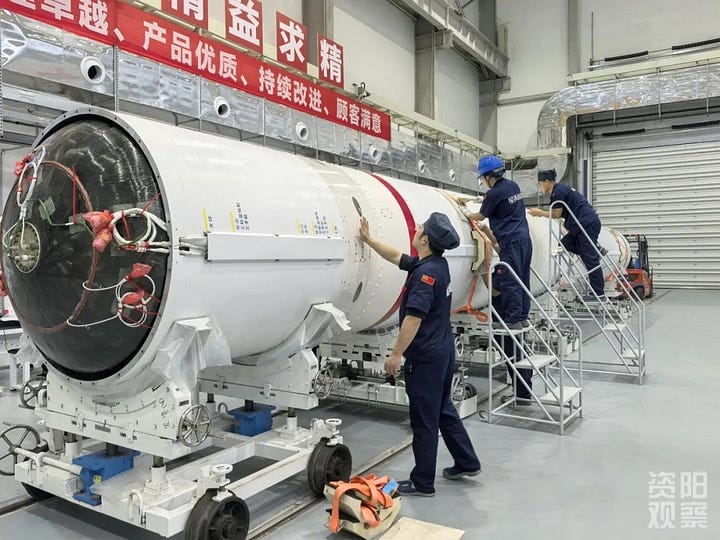Three Satellites Lost as Galactic Energy Suffers Launch Failure [Ceres-1 Y19]
It is the second failure in five years and the first since 2023.

At 12:02 pm China Standard Time (04:02 am Universal Coordinated Time) on November 10th, Galactic Energy attempted to fly its Ceres-1 launch vehicle into sun-synchronous orbit from the Jiuquan Satellite Launch Center. Sadly, after three stages of nominal flight, an anomaly occurred.
A few hours after the launch attempt, Galactic Energy wrote:
“At 12:02 on November 10, the Ceres-1 (Yao-19) carrier rocket lifted off from the Jiuquan Satellite Launch Center in China. The first, second, and third stages performed normally with successful separation. However, the fourth stage experienced an abnormal shutdown 510 seconds into flight, failing to place the satellite into orbit. The launch mission was unsuccessful. The specific cause is currently under further analysis and investigation.”
“We extend our sincerest apologies to our customers and all friends who care about and support Galactic Energy. We will continue to approach space technology with reverence, spare no effort in identifying the root cause of this failure, and rigorously organize the post-failure analysis and relaunch preparations for the Ceres-1 rocket to ensure the sustained success of future launch missions.”
“We will thoroughly learn from the lessons of this mission failure, continuously optimize our rocket design and quality management systems, and continue to advance China’s commercial space exploration with more reliable performance and steadier progress. We thank all sectors of society for their understanding and support. Galactic Energy will face challenges head-on and move forward firmly, contributing its due strength to the cause of space exploration.”
If there are any problems with this translation please reach out and correct me.


Today’s loss of a Ceres-1 is only the second ever for it since its debut flight in November 2020. Last time the vehicle failed it was in September 2023, following abnormal nozzle ablation on the first-stage.
After Galactic Energy’s statement, Xinhua named the three satellites lost during the launch attempt, they were: Jixing Gaofen 04C (吉星高分04C星), Jixing Platform 02A04 (吉星平台02A04星), and North China University of Technology Satellite-1 (中北大学一号卫星).
The failure of Ceres-1 will obviously affect other missions for the vehicle set to fly this year, as depending on the duration of the anomaly investigation and the way in which the fourth-stage failed, the rocket may not fly again until 2026. Ceres-2’s upcoming debut flight may also be delayed, as it uses an improved and enlarged version of the Galactic Energy-developed liquid propellant utilizing fourth-stage.
Today’s mission was the 22nd launch for the Ceres-1 launch vehicle series (Ceres-1 and Ceres-1S). This was also the 73rd launch attempt from China in 2025.
Liftoff video via Cosmic Penguin on Twitter.
Check out the previous Ceres-1 launch
Galactic Energy Lofts Three Satellites Into Orbit [Ceres-1 Y15]
Out of the Jiuquan Satellite Launch Center, Galactic Energy’s Ceres-1 blasted off on September 5th at 19:39 pm China Standard Time (11:39 am Universal Coordinated Time), flying into sun-synchronous orbit. A total of three satellites were on top of the rocket.
What is Ceres-1/1S?
This section is for those less familiar with China’s commercial launch vehicles.
Galactic Energy’s Ceres-1, and its sea launch version Ceres-1S, is a four-stage launch vehicle that burns solid fuel in the first three stages, and a storable propellant in the fourth-stage. The fourth-stage can also be replaced with the company’s Eros orbital test platform.
The payload capacity of the launch vehicle is currently as follows:
420 kilograms to low Earth orbit
300 kilograms to a 500-kilometer sun-synchronous orbit
270 kilograms to a 700-kilometer sun-synchronous orbit
The first-stage is powered by a solid rocket motor that burns an undisclosed solid propellant to produce 60 tons of thrust. The second-stage also burns an undisclosed solid propellant to produce 28 tons of thrust. The third-stage is the final solid rocket stage, once again burning an undisclosed solid propellant, producing 8.8 tons of thrust. The fourth-stage burns a storable liquid Monomethylhydrazine and mixed oxides of nitrogen fuel in an ‘attitude control thruster’ to generate 1 ton of thrust.
On the launchpad, Ceres-1 weighs 33,000 kilograms and stands 20 meters tall. The first, second, and third stage have a diameter of 1.4 meters while the fairing has a diameter of 1.6 meters.
So far Ceres-1 vehicles have flown from the Jiuquan Satellite Launch Center and various sea-based launch platforms.




![Galactic Energy Lofts Three Satellites Into Orbit [Ceres-1 Y15]](https://substackcdn.com/image/fetch/$s_!vSdS!,w_1300,h_650,c_fill,f_auto,q_auto:good,fl_progressive:steep,g_auto/https%3A%2F%2Fsubstack-post-media.s3.amazonaws.com%2Fpublic%2Fimages%2F48e71be6-34d2-466d-be0e-6c8e882cf21f_4049x2188.jpeg)
It does not matter even if 10 such more launches got failed because every failure provides lot of crucial data that the Rocket company should analyze to improve the launch . The most important thing for Galactic Energy is that they should focus on the reusable rockets only because expendable rockets era has almost gone and is actually not at all profitable . Let me give you guys one example , SpaceX , with just 18 of those dirty reusable boosters , dirty in a sense because they look dirty after being flown over and over again , can launch more than 100 Rockets of Falcon 9 which is an amazing feat.
So to win this Rockets' reusability race , every Chinese rocket company , yes , each one of them should only target reusable rockets otherwise China will be left far behind in this space infrastrcutre building . NRO and NASA are fastly deploying dozens of military and classified rockets to monitor China and it is believed that already NRO has a huge infrastructure of spy sattelites in the LEO , MEO and GEO to counter China , so China has no other option but to focus on reusable rockets and launch heavy spy and classified sattelites to counter NASA and ESA.
Regards
Dr. Edison , China